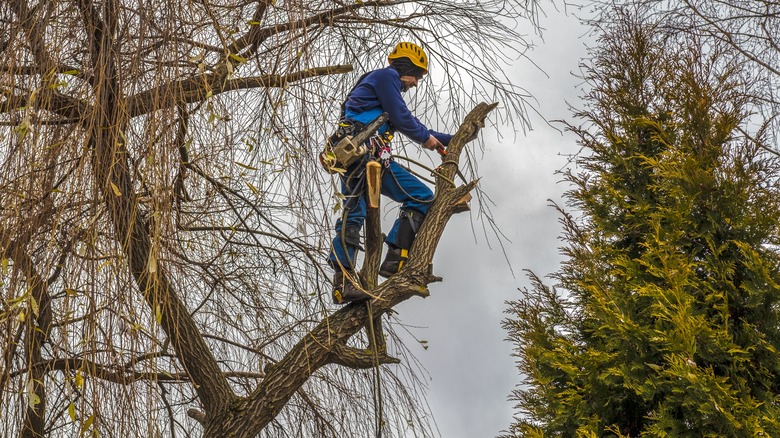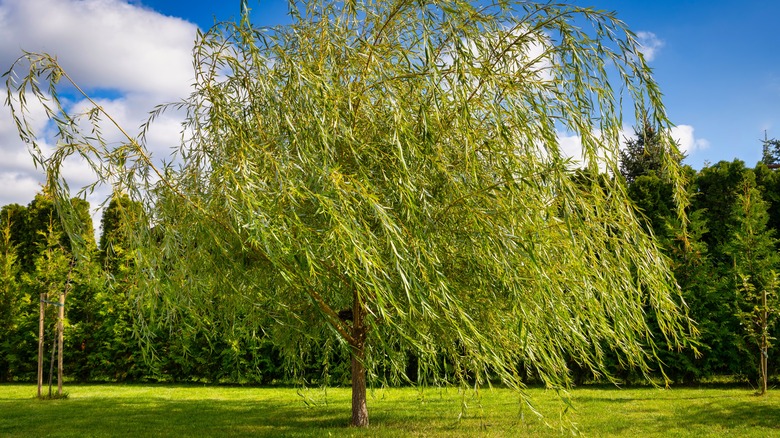The statement-making willow tree is known for its long, flowing branches and slender leaves. Beautiful fall colors, ground-sweeping branches, and bright green foliage can make an instant impression on a home’s landscape with a well-cared-for tree. Though willows don’t need a lot of maintenance, proper trimming and pruning will help encourage growth and fullness in the branches. However, mistakes like trimming at the wrong time of the year or not removing damaged branches can lead to a struggling tree.
There are two common types of willow trees. Some naturally grow upwards with branches that form arches at a variety of levels as the tree reaches new heights. The second type, often called a grafted willow tree, incorporates grafted branches to create a desirable shape These willows to be more structured with fewer areas of unique bends. Both types of willow trees need to be pruned to keep them growing and flourishing.
As a willow grows, you may notice branches that sprout at the head or top of the tree, jutting out from the common arch of the branches. In grafted trees, you’ll need to remove these over time to maintain the desired shape. Most naturally growing willow trees will have a natural tiered effect, with all branches eventually curving and flowing downwards. Before you take a pruning shear to these trees, there are several mistakes you need to avoid. One key issue to avoid: pruning branches in the spring, when the tree is busy growing.
Don’t prune a willow tree during the spring

Willow trees begin to come to life in spring, producing stunning yellow twigs and bright green foliage. In this season, willow trees become a critical food source and protective structure for many young pollinators, including birds. Those small flowers need every ounce of the tree’s efforts to grow, which is why trimming your willow tree during the spring months, when it’s focused on new growth, isn’t ideal (unless there is significant disease or damage that must be removed).
Willow trees begin to flourish as early as late February in some areas. That means you’ll want to do any trimming in the late fall or winter, when the tree is dormant and there are no leaves on the branches. Dormant pruning provides a better view of the tree’s branch structure (making it easier to pick out those areas that need trimming to keep the willow’s flowing shape). Pruning at this time also helps minimize the spread of disease since most insects and diseases are also dormant at this period. In general, it’s far less stressful on the tree to prune it at this time.
When a willow is pruned during the winter months, the new spring growth will be stunning, as the tree’s energy will be put toward that new growth. Even if you made a pruning mistake by not trimming during the winter, avoid spring pruning when possible.
Don’t ignore damaged or diseased branches

Though willows are rather hardy and not susceptible t damage, a strong storm can lead to broken branches or other significant structural damage. An otherwise healthy tree should only require removal of the damaged sections to encourage it to flourish again, especially if the issue is in one of the more minor branches. When a larger limb suffers significant damage, it’s more challenging for the tree to recover without some help. Trimming away the damage is often best, as long as you can leave at least half of the tree’s crown in place (more than that makes it a candidate for removal).
Willow trees also need trimming when there are signs of disease such as leaf spot, black canker, and willow scab, all of which can kill untreated trees. Significant pest infestation can also be a concern. Trimming off these damaged areas and then sealing the tree wounds may prevent either from spreading. Other treatments for disease and pest infestations may be necessary as well.
It’s always a good idea to have an arborist come out to determine the best course of action for managing significant diseases or infestations, especially if you have numerous willow trees nearby that could also suffer. Left untreated, many of these issues can cause a hollowing of the tree, making it a safety risk.




